Related Research Articles

A keyset or chorded keyboard is a computer input device that allows the user to enter characters or commands formed by pressing several keys together, like playing a "chord" on a piano. The large number of combinations available from a small number of keys allows text or commands to be entered with one hand, leaving the other hand free. A secondary advantage is that it can be built into a device that is too small to contain a normal-sized keyboard.

QWERTY is a keyboard layout for Latin-script alphabets. The name comes from the order of the first six keys on the top letter row of the keyboard. The QWERTY design is based on a layout included in the Sholes and Glidden typewriter sold via E. Remington and Sons from 1874. QWERTY became popular with the success of the Remington No. 2 of 1878, and remains in ubiquitous use.

A wearable computer, also known as a body-borne computer, is a computing device worn on the body. The definition of 'wearable computer' may be narrow or broad, extending to smartphones or even ordinary wristwatches.
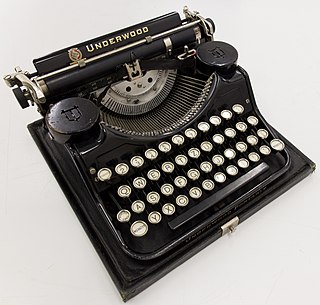
A typewriter is a mechanical or electromechanical machine for typing characters. Typically, a typewriter has an array of keys, and each one causes a different single character to be produced on paper by striking an inked ribbon selectively against the paper with a type element. At the end of the nineteenth century, the term 'typewriter' was also applied to a person who used such a device.

The QWERTZ or QWERTZU keyboard is a typewriter and keyboard layout widely used in Central and Southeast Europe. The name comes from the first six letters at the top left of the keyboard:.

A function key is a key on a computer or terminal keyboard that can be programmed to cause the operating system or an application program to perform certain actions, a form of soft key. On some keyboards/computers, function keys may have default actions, accessible on power-on.
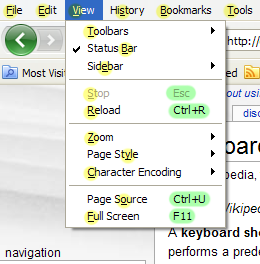
In computing, a keyboard shortcut also known as hotkey is a series of one or several keys to quickly invoke a software program or perform a preprogrammed action. This action may be part of the standard functionality of the operating system or application program, or it may have been written by the user in a scripting language. Some integrated keyboards also include pointing devices; the definition of exactly what counts as a "key" sometimes differs.
Touch typing is a style of typing. Although the phrase refers to typing without using the sense of sight to find the keys—specifically, a touch typist will know their location on the keyboard through muscle memory—the term is often used to refer to a specific form of touch typing that involves placing the eight fingers in a horizontal row along the middle of the keyboard and having them reach for specific other keys. Both two-handed touch typing and one-handed touch typing are possible.
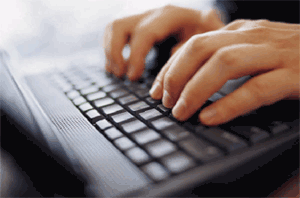
Typing is the process of writing or inputting text by pressing keys on a typewriter, computer keyboard, mobile phone, or calculator. It can be distinguished from other means of text input, such as handwriting and speech recognition. Text can be in the form of letters, numbers and other symbols. The world's first typist was Lillian Sholes from Wisconsin in the United States, the daughter of Christopher Sholes, who invented the first practical typewriter.
A keyer is an electronic device used for signaling by hand, by way of pressing one or more switches. The technical term keyer has two very similar meanings, which are nonetheless distinct: One for telegraphy and the other for accessory devices built for computer-human communication:
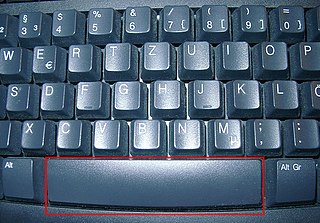
The space bar, spacebar, blank, or space key, Space bar is a key on a typewriter or alphanumeric keyboard in the form of a horizontal bar in the lowermost row, significantly wider than all other keys. Its main purpose is to conveniently enter a space, e.g., between words during typing.

Arrow keys or cursor movement keys are keys on a computer keyboard that are either programmed or designated to move the cursor in a specified direction.
The PLUM keyboard is a keyboard layout which differs from the traditional QWERTY keyboard in both physical key layout and letter arrangement. Unlike most keyboards, the PLUM keyboard organizes keys in a square grid, as opposed to the staggered rows of a typewriter. Though the Plum Keyboard is currently off-line, it is still being promoted.
Samsung SCH-U940 is a Verizon Wireless touch-screen smartphone made by Samsung. The Glyde was based on the popular European Croix, but was later adapted for the United States. It was released in late May 2008 in Verizon stores. As of August 2009, the phone is no longer listed for sale on Verizon's website. The phone features touch screen navigation, a 2.0-megapixel camera/camcorder with flash, customizable shortcut menus, and a full HTML browser. The phone has been replaced by a newer version, the Samsung Rogue.
The form factor of a mobile phone is its size, shape, and style, as well as the layout and position of its major components.

Dvorak is a keyboard layout for English patented in 1936 by August Dvorak and his brother-in-law, William Dealey, as a faster and more ergonomic alternative to the QWERTY layout. Dvorak proponents claim that it requires less finger motion and as a result reduces errors, increases typing speed, reduces repetitive strain injuries, or is simply more comfortable than QWERTY.

A keyboard layout is any specific physical, visual, or functional arrangement of the keys, legends, or key-meaning associations (respectively) of a computer keyboard, mobile phone, or other computer-controlled typographic keyboard.
The idea of one-hand typing is to touch type using only one hand, or mainly one hand. Its history and application are closely related to keyboard research on QWERTY and Dvorak keyboard layouts.
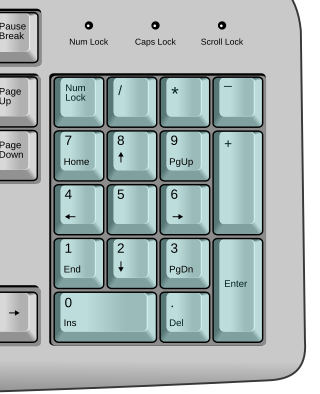
A numeric keypad, number pad, numpad, or ten key, is the palm-sized, usually-17-key section of a standard computer keyboard, usually on the far right. It provides calculator-style efficiency for entering numbers. The idea of a 10-key number pad cluster was originally introduced by Tadao Kashio, the developer of Casio electronic calculators.

MessagEase is an input method and virtual keyboard for touchscreen devices. It relies on a new entry system designed by Saied B. Nesbat, formatted as a 3x3 matrix keypad where users may press or swipe up, down, left, right, or diagonally to access all keys and symbols. It is a keyboard that was designed for devices like cell phones, mimicking the early cell phones' limited number of 12 keys.
References
- ↑ Morley, Deborah; Parker, Charles (2013). Understanding Computers: Today and Tomorrow (14th ed.). Boston: Cengage Learning. p. 665. ISBN 9781133190240 . Retrieved 24 November 2014.
- ↑ Matias, Edgar; MacKenzie, I. Scott; Buxton, William (1993). "Half-QWERTY: a one-handed keyboard facilitating skill transfer from QWERTY". Proceedings of the INTERCHI '93 Conference on Human Factors in Computing Systems: 88–94. ISBN 90-5199-133-9.
- ↑ Lawrence, Elaine; Pernici, Barbara; Krogstie, John (30 August 2004). Mobile Information Systems. New York: Springer Science+Business Media. p. 332. ISBN 9780387228518 . Retrieved 24 November 2014.